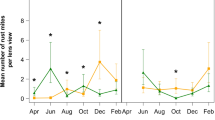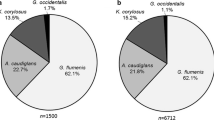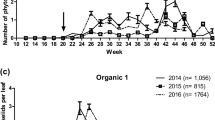Abstract
Seasonal history studies and a pesticide disruption trial showed that the Australian phytoseiidAmblyseius victoriensis (Womersley) was a very effective predator of the native eriophyidTegolophus australis Keifer, in commercial citrus orchards at Gayndah and Mundubbera, Queensland, from 1984 to 1990.Amblyseius victoriensis numbers rose from 10–20 per 100 leaves in spring to 100 or more per 100 leaves in mid summer, keeping the percentage ofT. australis-infested, fruit well below an economic threshold of 10%.
However, in the same orchards,A. victoriensis only controlled the cosmopolitan eriophyidPhyllocoptruta oleivora (Ashmead), when less than 5% of the fruit was infested with the pest and predator numbers exceeded 40 per 100 leaves.
Aspects of orchard management influencing populations ofA. victoriensis, were evaluated. The pesticides benomyl, dicofol, mancozeb, methidathion, and mezineb reduced populations by 100%, methomyl by 89%, chlorpyrifos by 80%, fenbutatin oxide by 42.5% and endosulfan by 27.5%. Iprodione and hydrated lime caused a 17% reduction, but copper oxychloride and narrow-range oil had little effect. Encouragement of alternative host plants in the orchard increased populations ofA. victoriensis. Where Rhodes grass.Chloris gayana Kunth, was allowed to flower in the inter-rows, its windblown pollen served as a supplementary food source. Windbreak rows ofEucalyptus torelliana F. Muell. acted as reservoirs ofA. victoriensis for nearby blocks of citrus. Augmentative release was effective for re-establishingA. victoriensis where it was absent following pesticide suppression.
Similar content being viewed by others
References
Broadley, R.H., Smith, D., Papacek, D.F., Owen-Turner, J.C., Chapman, J.C., Banks, A.G. and Mayers, P., 1987. Protect your citrus. Qld. Dep. Primary Ind. Inf. Ser., Q187012: 141 pp.
Goodwin, S., 1984. Biological control of Acari: Laboratory evaluation of pesticides on an Australian strain of the Chilean predatory mite,Phytoseiulus persimilis Athias-Henriot. In: D.A. Griffiths and C.E. Bowman (Editors), Acarology VI, Vol. 2. Ellis Horwood, Chichester, pp. 647–654.
Hoy, M.A., Groot, R. and Van de Baan, H.E., 1985. Influence of aerial dispersal on persistence and spread of pesticide resistantMetaseiulus occidentalis in California almond orchards. Entomol. Exp. Appl., 37: 17–31.
Huang Ming-dau, 1978. Studies on the integrated control of the citrus red mite with the predaceous mite as a principal controlling agent. Acta Entomol. Sinica, 21: 260–270 (in Chinese, with English abstract).
Huffaker, C.B. and Kennett, C.E., 1953. Differential tolerance to parathion in twoTyphlodromus predators on cyclamen mite. J. Econ. Entomol., 46: 707–708.
James, D.J., 1989a. Influence of diet on development, survival and oviposition in an Australian phytoseiid,Amblyseius victoriensis (Acari: Phytoseiidae). Exp. Appl. Acarol., 6: 1–10.
James, D.J., 1989b. Overwintering ofAmblyseius victoriensis (Womersley) (Acarina: Phytoseiidae) in southern New South Wales. Gen. Appl. Entomol., 21: 51–55.
Jeppson, L.R., McMurtry, J.A., Mead, D.W., Jesser, M.J., and Johnson, H.G., 1975. Toxicity of citrus pesticides to some predacious phytoseiid mites. J. Econ. Entomol., 68: 707–710.
Kennett, C.E., Flaherty, D.L. and Hoffman, R.W., 1979. Effect of wind-borne pollens on the population dynamics ofAmblyseius hibisci (Acarina: Phytoseiidae). Entomophaga, 24: 83–98.
McMurty, J.A. and Scriven, G., 1965. Insectary production of phytoseiid mites. J. Econ. Entomol., 58: 282–284.
Overmeer, W.P.J., Doodeman, M. and Van Zon, A.Q. 1982. Copulation and egg production inAmblyseius potentillae andTyphlodromus pyri (Acarina: Phytoseiidae). Z. Angew. Entomol., 93: 1–11.
Schicha, E., 1987. Phytoseiidae of Australia and Neighbouring Areas. Indira Publishing, Oak Park, Michigan, 187 pp.
Smith, D., 1972. Queensland Department of Primary Industries, Entomology Annual Report for 1972 Nambour.
Smith, D. and Papacek, D.F., 1984. Integrated control ofAonidiella aurantii (Maskell) and other citrus pests at Mundubbera, Queensland. Qld. Dep. Primary Ind. Bull., Series QB84002: 16 pp.
Smith, D. and Papacek, D.F., 1985. Integrated pest management in Queensland citrus. Qld. Agric. J., 111: 249–259.
Watve, C.M. and Lienk, S.E., 1975. Responses of two phytoseiid mites to pesticides used in New York apple orchards. Environ. Entomol., 4: 797–800.
Author information
Authors and Affiliations
Rights and permissions
About this article
Cite this article
Smith, D., Papacek, D.F. Studies of the predatory miteAmblyseius victoriensis (Acarina: Phytoseiidae) in citrus orchards in south-east Queensland: control ofTegolophus australis andPhyllocoptruta oleivora (Acarina: Eriophyidae), effect of pesticides, alternative host plants and augmentative release. Exp Appl Acarol 12, 195–217 (1991). https://doi.org/10.1007/BF01193467
Accepted:
Issue Date:
DOI: https://doi.org/10.1007/BF01193467




